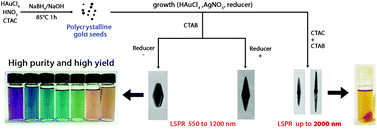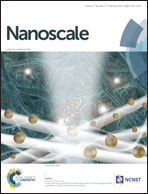From gold nanobipyramids to nanojavelins for a precise tuning of the plasmon resonance to the infrared wavelengths: experimental and theoretical aspects†
Abstract
Anisotropic gold nanoparticles and in particular with shapes exhibiting tips are known to present an extremely strong localized electromagnetic field. This field is mostly located at the top of the tips and can be used in various optical applications. Moreover, as a consequence of their anisotropy, they present two plasmon resonance bands corresponding to the transverse and longitudinal resonance modes. Tuning the aspect ratio it becomes possible to display SPR bands near the near infrared region. This was particularly investigated in the case of nanorods and also for bipyramids. In this paper we report a high yield synthesis approach that allows one to precisely control the aspect ratio of bipyramids and to elongate the structure until they adopt a javelin-like aspect. We were able to prepare nano-javelins with surface plasmon resonances up to 1850 nm, opening important perspectives in terms of optical applications in the NIR and IR regions. The synthetic methods are fully reported and the optical properties were correlated with the theoretical approach, taking into consideration not only the aspect ratio but also the truncation of the nano-objects.


 Please wait while we load your content...
Please wait while we load your content...